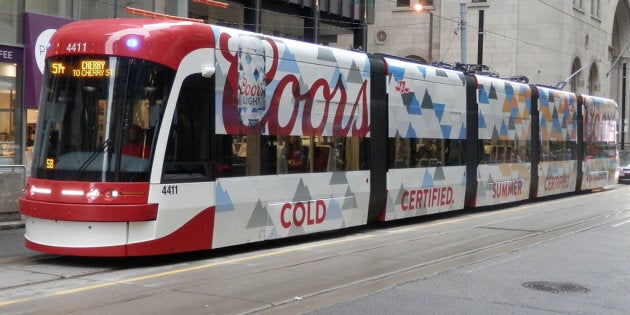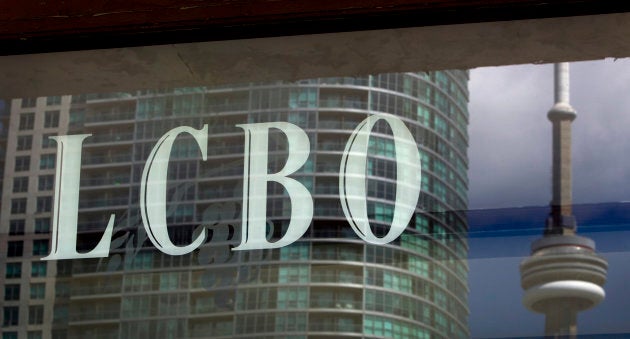
Ontario, we have an alcohol problem.
While Canadians spent $22.1 billion dollars on alcohol in the last year, the Liquor Control Board of Ontario (LCBO) delivered a dividend to the Ontario government in the amount of $1.935 billion in 2015-6. Certainly a "cash cow" for government, the increase in revenue and sales was celebrated as a record for Ontario, but also presents a major barrier to meaningful change in the name of individual and community health.
I was prompted to write this by a new billboard in my Toronto neighbourhood: a icy, dark can for a new "stronger" lemonade cooler with the tagline, "KAPOW Right in the Kisser!" As a cannabis policy researcher, I was shocked by the messaging, particularly juxtaposed against current concerns around cannabis: quite literally a public invitation to consume more for less. These type of ad campaigns around alcohol have become increasingly normalized and have continued to push the boundaries of what is acceptable, whether it's the messaging itself, the placement, or the sheer number of appearances they seem to make in public spaces as of late. With the current warm weather, we've all been offered at least one free promotional beverage somewhere downtown in the city.
In Ontario, alcohol distribution is monopolized by the government through the LCBO, and truth be told, compared to other provinces this model has some good public health outcomes because of the ways it restricts access and availability. But, their stated "social responsibility" mandate often feels like lip service -- the LCBO has work to do in promoting the safe consumption of alcohol in practice and on site.

Then there's Ontario's provincial marketing regulations around alcohol, which come in part from the Canadian Radio-television and Telecommunications Commission (CRTC), and the Alcohol and Gaming Commission of Ontario, and include provisions such as restricting advertisements in places frequented by youth under the drinking age. Is it really the case that giant billboards on the side of main artery in the city of Toronto is not considered a place "frequented by underage youth"?
As Canadians, our attitudes generally towards alcohol is exemplified in a quote by MP Joël Godin Portneuf, a Conservative MP from Quebec, during the second reading of the Cannabis Act, the tabled legislation for the regulation of cannabis:
"We cannot compare alcohol to drugs, because they do not compare. Alcohol is one element called "alcohol." Drugs are a huge range of products that are toxic and harmful to people's health...To my knowledge, there are no studies that talk about permanent damage with regard to alcohol..."
The irony here is rich, but its also very dangerous. Alcohol has been research and discussed by experts as the most important risk factor for burden of disease. According to the World Health Organization, alcohol is responsible for approximately 5.1 per cent of the global burden of disease and injury. Each year across the globe, 3.3 million deaths result from the harmful use of alcohol. And yet we continue to see the boundaries of what is deemed "acceptable" in alcohol advertising and promotion extended, as if it slips through the cracks and becomes more pronounced and in-your-face while we mull over cannabis legalization.
In the context of the legalization of cannabis, Canada's primary concern has been youth, and understandably so. With some of the highest rates of use in the world, young people should be a major consideration in getting this legislation right. Canadian Students for Sensible Drug Policy held a youth roundtable on cannabis legalization in Toronto, and unsurprisingly, young people often pointed to the glaring hypocrisy in the way we talk about these two substances, and also interestingly, felt that the current system served to incentivized binge drinking when they turned 19 years of age. In fact, Ontario should use cannabis legalization as an opportunity to rethink what is happening with the alcohol.
If we lived in a world where actual harms guided policy, a different picture of regulation would certainly emerge.
While alcohol is most people's drug of choice, it certainly deserves tighter restrictions in light of its extremely burdensome health risks, particularly when it comes to advertising and promotion. It becomes clear that alcohol sales and promotion in Ontario highlights a fundamental disjuncture between harm reduction and prevention, and maximizing profit.
The idea of tightening alcohol regulations more generally is wildly unpopular -- in fact, Ontario has been moving towards the deregulation of alcohol leading to the sales of beer and wine in some grocery stores. I get it -- I personally enjoy a cold pint and I am sometimes inconvenienced by the hours or availability of booze. But this doesn't mean we shouldn't increase regulation and accountability around the widespread promotion and advertising of alcohol. At what point do we truly consider how the normalization of alcohol has actually lent itself to the minimization of its clears risks and harms, and continues to justify its consumption through advertising and promotion which repackages its messaging as fun and relaxing?
There is even scientific evidence emerging which debunks the persistent idea that "one glass of wine a day is good for you." The evidence continues to build -- one 2016 review of existing evidence even concluded there is "existing epidemiological evidence supports a causal association of alcohol consumption with cancers at seven sites: oropharynx, larynx, oesophagus, liver, colon, rectum and female breast." If we lived in a world where actual harms guided policy, a different picture of regulation would certainly emerge.
In comparison to other drugs, a well-known study by Dr. David Nutt published in the Lancet in 2010 (one of the most prestigious medical journals in the world), rated the harms caused by the misuse of a wide spectrum of drugs. Overall, and perhaps surprising to some, alcohol was evaluated as the most harmful drug. Alcohol's legally regulated availability means that many more people have access to it, but this type of work should serve as a wake up call, or at least help to contextualize what is at stake.
We need to have a sober look at advertising and promotion in our city streets and public places. I see very little reason why alcohol advertisements should be allowed, for example, in and on our public transportation services -- services used daily by youth. Changing drug regulation in Canada is a opportune moment to review of our current alcohol advertising regulatory system, and address the logic guiding policy.
Follow HuffPost Canada Blogs on Facebook
Also on HuffPost: